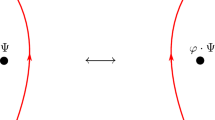Abstract
In systems like Yang-Mills or gravity theory, which have a symmetry of gauge type, neither phase space nor configuration space is a manifold but rather an orbifold with singular points corresponding to classical states of non-generically higher symmetry. The consequences of these symmetries for quantum theory are investigated. First, a certain orbifold configuration space is identified. Then, the Schrödinger equation on this orbifold is considered. As a typical case, the Schrödinger equation on (double) cones over Riemannian manifolds is discussed in detail as a problem of selfadjoint extensions. A marked tendency towards concentration of the wave function around the singular points in configuration space is observed, which generically even reflects itself in the existence of additional bound states and can be interpreted as a quantum mechanism of symmetry enhancement.
Similar content being viewed by others
References
de Barros Cobra, B.: Doctoral Thesis, Freiburg 1986; de Barros Cobra, B., Römer, H.: Lett. Math. Phys.13, 189 (1987)
Arms, J. M., Marsden, J. E., Moncrief, V.: Commun. Math. Phys.78, 455 (1981)
Otto, M.: J. Geom. Phys.4, 101 (1987)
Ashtekar, A., Horowitz, G. T.: Phys. Rev.D26, 3342 (1982); Gotay, M.J.: Class quantum gravity3, 487 (1986)
Śniatycki, J., Weinstein, A.: Lett. Math. Phys.7, 155 (1983)
Arms, J.: J. Math. Phys.20, 443 (1979)
Arms, J.: J. Math. Phys.90, 361 (1981)
In a completely different framework scattering on a cone has been considered by de Sousa Gerbert, P., Jackiw, R.: MIT preprint, CTP#1594. Selfadjoint extensions of the oscillator Hamiltonian on ℝ3 minus a line is discussed in: Doebner, H. D., Elmers, H. J., Heidenreich, W. F.: J. Math. Phys.30, 1053 (1989), whereas Exner, P., Sěba, P.: Lett. Math. Phys.12, 193 (1986) treat free movement on two planes with one point identified.
Abraham, R., Marsden, J. E.: Foundations of mechanics. Second ed., Updated 1985 Printing, Reading MA: The Benjamin/Cummings 1978
Montgomery, D.: Compact groups of transformations. In: Differential analysis, papers presented at the Bombay Colloquium 1964. Oxford: Oxford University Press
Mostow, G. D.: Ann. Math.65, 432 (1957); Mostow, G. D.: Ann. Math.65, 513 (1957)
Montgomery, D., Samelson, H., Yang, C. T.: Ann. Math.64, 131 (1955)
Montgomery, D., Samelson, H., Zippin, L.: Ann. Math.63, 1 (1955)
Hurewicz, W., Wallman, H.: Dimension theory. Princeton, NJ: Princeton University Press 1948
Author information
Authors and Affiliations
Additional information
Communicated by A. Jaffe
Rights and permissions
About this article
Cite this article
Emmrich, C., Römer, H. Orbifolds as configuration spaces of systems with gauge symmetries. Commun.Math. Phys. 129, 69–94 (1990). https://doi.org/10.1007/BF02096779
Received:
Issue Date:
DOI: https://doi.org/10.1007/BF02096779



